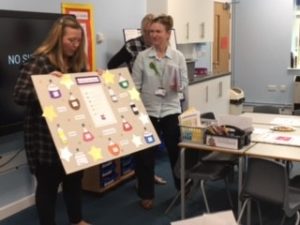Words: Victoria Mitchell, ALL
Before October half term, I had the opportunity to deliver training for the Language Futures initiative as part of a school’s INSET day. Sir Edmund Hillary Primary School in Worksop, Nottinghamshire were keen to get underway with the Language Futures approach but needed a staff CPD session covering the main aims of Language Futures, how the approach works, how it differs to ‘normal’ language teaching, and to assist with planning.
Headteacher, Chris Guest, says of the approach “we chose Language Futures when the school lost our very experienced languages specialist teacher and needed to continue teaching but without having the language expertise within school. Initial panic from staff soon became, “I can do that!” thanks to the support and guidance of the Language Futures team. It is a practical and pragmatic way of creating a learning culture based on building relationships between teachers, pupils and their communities with a love of languages at its heart. I’m delighted we came across it.”
Throughout the day, the staff were incredibly enthusiastic (the Spanish themed lunch was well received!) and, as there are no specialist language teachers amongst them, relished the idea that the teacher does not have to be ‘an expert’. Adults can actually learn along with the children, assisted by language mentors. Lucy, language coordinator for the school, says ‘’The Language Futures approach is a great way to engage children in their learning. I love the way the children take ownership and the lessons are directed by them. The children are immersed in the language and having language mentors is a fantastic way to enrich this. In addition, we are building links with the local community and the children enjoy talking in Spanish.’
Language Futures is ideal for primary schools as it follows the model of Project Based Learning. The primary curriculum is centred around topics so it seems ideal to enable pupils to investigate a language at the same time. It fitted into Sir Edmund Hillary’s curriculum plans perfectly. By the end of the day, the projects for all year groups had mapped how to incorporate Spanish into their topics and had planned their first half term’s work. Projects ranged from, ‘Stargazers’, ‘A day in the life of a Spanish speaking pupil’, ‘Animals’, Creating a magic potion’, to reading the book ‘Dear Zoo’ in Spanish. Of course the teacher’s knowledge of Spanish does not extend to these topics – it doesn’t have to. The pupils investigate the theme independently and decide upon their project outcome. I, along with staff, am excited to see the results.
To find out how your school can get involved in the Language Future’s approach, please contact Clodagh Cooney on [email protected].




